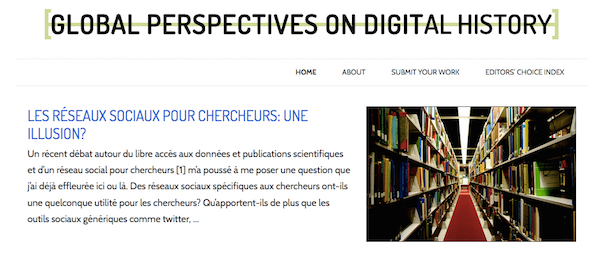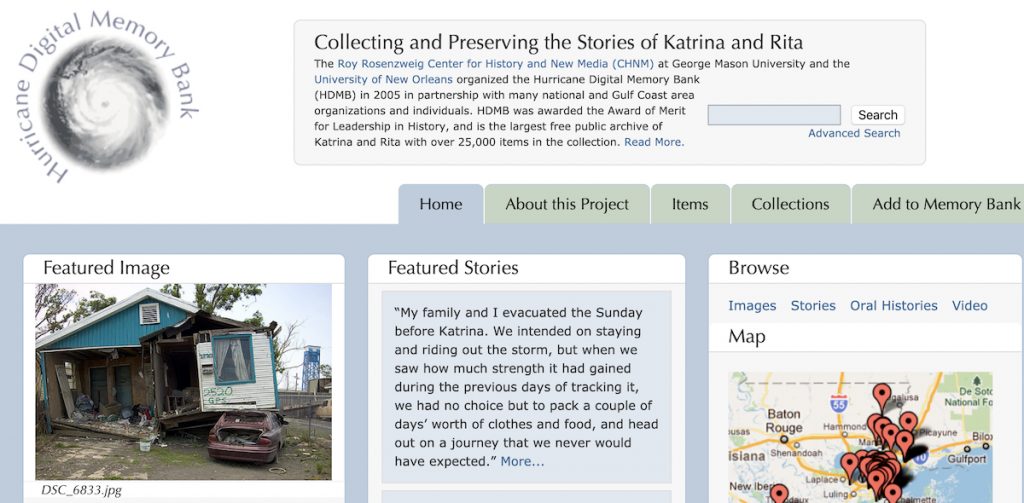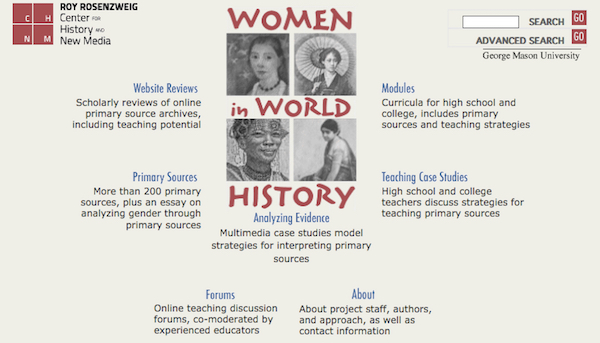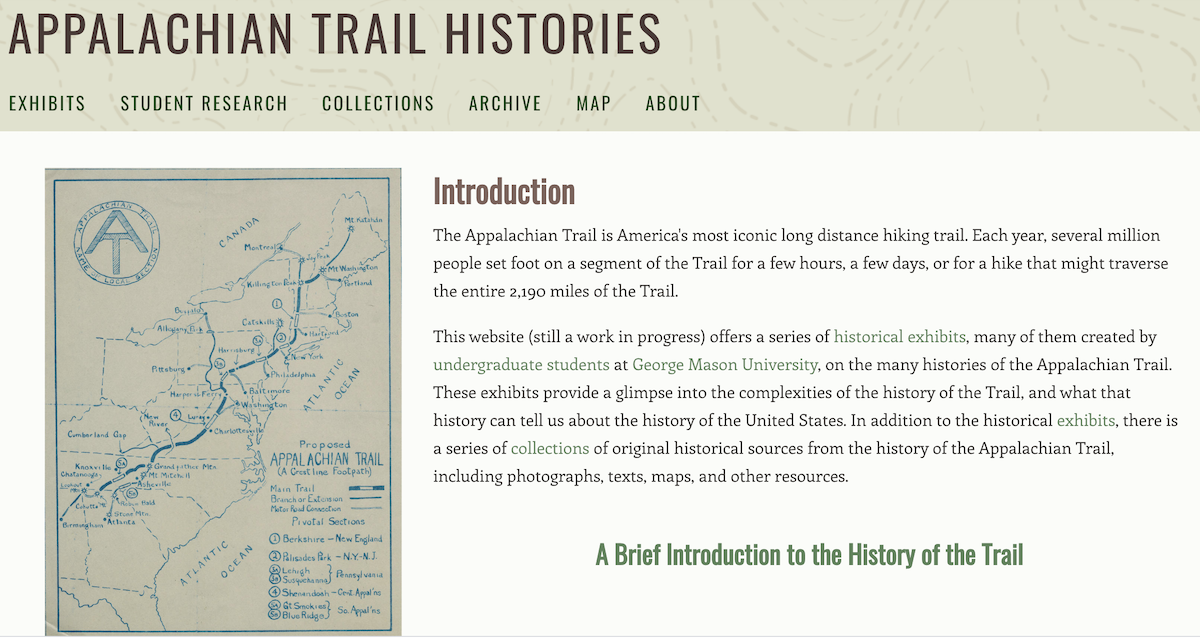My work as a scholar spans several academic genres. I began my career as a historian of East Central Europe, specifically focused on Czech nationalist politics in the late Habsburg Empire. That work resulted in a book and a number of peer-reviewed articles in a variety of journals. Beginning in the late 1990s I turned increasingly toward the digital humanities and the scholarship of teaching and learning. Over the years my work in these areas has resulted in international, national, state, and university awards for excellence. Grants I have have written in collaboration with colleagues have resulted in more than $1 million in external funding. And digital projects that I and my collaborator Kelly Schrum created won a major award from the American Historical Association.
Since 2014 my work as a scholar has become increasingly focused on public digital history, a natural outgrowth of the digital work I’ve done previously. My most recent project, Appalachian Trail Histories, marries my interests in public digital history and the scholarship of teaching and learning.
Digital projects I have led or helped lead include:

To hikers, the Appalachian Trail looks and feels as though it has been engraved into the mountains for almost a century, following the same well-worn path that hikers have taken since the trail was declared complete in 1937. But the trail has followed many different twists and turns over the decades since work began in 1925. When it was declared complete in 1937, the trail covered 2,050 miles, as compared to the 2,192 miles of its route in 2020. Of all the changes in the trail’s route over the decades, the single largest change was in Southwestern Virginia in 1952, where 300 miles of trail, almost 15% of the entire route at that time, was abandoned in favor of the route the trail takes through the region today. Virginia’s Lost Appalachian Trail, funded by a small grant from the Virginia Foundation for the Humanities, tells the story of that lost section of trail and the communities along the old route. [Project dates: 2019-present; Role: Principal Investigator. Funding to date: $9,000]
The Appalachian Trail, first dreamed up by Benton MacKaye in 1921, is one of America’s three long distance National Scenic Trails (along with the Pacific Crest and Continental Divide Trails). Of the three, the Appalachian Trail sees the heaviest use – estimates generally float around 3 million people per year walk some portion of the trail’s 2,192 miles – and it remains the most famous, both as a fixture in popular culture and as a beacon to the adventurous, those who hope a hike will change their lives for the better, and those who just want to spend a few hours or a few days taking a walk in the woods. Appalachian Trail Histories is both a digital public history project highlighting my own work on the many histories of the Appalachian Trail, and a teaching project, giving my students a platform for displaying the results of their own research and technical skills with digital media. [Project dates: 2017-present; Role: Principal Investigator. Grant funding to date, $30,000.]

Teaching History in the Digital Age (2013)
“It is superb: something everyone interested in digital history will have to read.â€
— Stanley Katz, Princeton University
“History educators have for the most part been slow to embrace the digital world inhabited by their students in their teaching. This book is part practical attempt to encourage and assist them to do so; part reflective meditation on what history ‘is’ and how historians think about fostering higher learning through history; and part impassioned appeal for historians to recast what they do in the classroom in light of a changed student population.â€
— Alan Booth, University of Nottingham

In addition to my current work on the history of the Appalachian Trail, I have held a number of leadership roles in digital projects that focus on emerging scholarship, the scholarship of teaching and learning, and creating new online resources for teachers and students.

Global Perspectives on Digital History (GPDH) was an experimental publication in 2011-2012 that aggregated content from our Compendium of the Global Perspectives, drawing from hundreds of venues where high-quality scholarship is likely to appear, including the personal websites of scholars, institutional sites, blogs, and other feeds. It also seeks to discover new material by monitoring Twitter and other social media for stories discussed by the community, and by continuously scanning the broader web through generalized and specialized search engines. Scholarship—in whatever form—that drives the field forward was highlighted in the Editors’ Choice column. Global Perspectives also offered Short Takes, items from the venues we monitor that are brief, but which offer important insights into or news on digital history around the world. The languages of Global Perspectives were English, German, and French. GPDH was part of the larger PressForward project at the Roy Rosenzweig Center for History and New Media.  [Project dates: 2011-2013; Role: Co-Editor in Chief]

Few images from the second half of the twentieth century endure as vividly as the jubilant crowds atop the Berlin Wall in 1989, seemingly tearing down the Cold War with their hammers, hands, and hopes. Just as memorable was the sight of hundreds of thousands of people filling Wenceslaus Square in Prague, chanting “Truth Will Prevail†as the communist regime crumbled before their eyes. Teachers and their students have little access to vivid historical documents in English that convey the epochal events of 1989 and so we developed this digital project focused on teaching and learning about the events of that tumultuous year and what followed. Making the History of 1989 has three key features: a substantial collection of high quality primary sources; a set of multimedia interviews that make visible the processes by which historians transform events and sources into historical narratives; and lesson plans and document based questions provide historical context, tools, and strategies for teaching the history of 1989 with primary sources in ways that make “history making†visible and vivid. [Project dates: 2006-2009; Role: Principal Investigator. Grant funding, $190,000.]

Following the devastating hurricane season of 2005 along America’s Gulf Coast, RRCHNM and the University of New Orleans collaborated on the Hurricane Digital Memory Bank, which collected and preserved the digital history of hurricanes Katrina, Rita, and Wilma, and was supported by a grant from the Alfred P. Sloan Foundation. I joined this project two years after it began as a co-producer with my colleague Sheila Brennan, working closely with our close friend and collaborator, the late Michael Mizell-Nelson. [Project dates: 2005-2009; Role: Co-Producer]

World history teachers face many challenges to incorporating primary sources in their teaching—pressures of coverage in survey courses, lack of available materials, and inadequate training in dealing with unfamiliar sources. These issues are especially challenging for teaching the history of women in the world. Women in World History provides an online curriculum resource center to help high-school and college world history teachers and their students locate, analyze, and learn from primary sources dealing with women and gender in world history. Women in World History reflects three approaches central to current scholarship in world history and the history of women: an emphasis on comparative issues rather than civilizations in isolation; a focus on contacts among different societies; and an attentiveness to “global†forces, such as technology diffusion, migration, or trade routes, that transcend individual societies. Project materials also utilize recent advances in our understanding of how historical learning takes place, including complex interaction with sources, recursive reading, and skills used by historians. [Project dates: 2003-2005; Role: Co-Director. Grant funding $250,000.]
World History teachers face many challenges to incorporating primary sources in their teaching—the pressures of coverage in survey courses, the lack of available materials, and inadequate training in dealing with unfamiliar sources from a range of cultures. World History Sources responds to these challenges (as well as the new opportunities offered by the Internet) by offering a website to help world history teachers and students locate, analyze, and learn from online primary sources and to further their understanding of the complex nature of world history, especially the issues of cultural contact and globalization. World History Sources reflects three approaches central to current world history scholarship: an emphasis on comparative issues rather than civilizations in isolation; a focus on contacts among different societies and the economic, social, and cultural consequences of those contacts; and an attentiveness to “global†forces that transcend individual societies or even societies in mutual contact—forces such as technology diffusion, migration, disease transmission, extension and realignments of trade routes, or missionary outreach. [Project dates: 2002-2004; Role: Co-Director. Grant funding, $280,000.]

